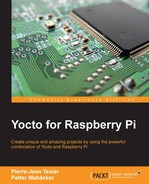This book will cover everything from creating your customized image for the Raspberry Pi to implementing a small home automation project using the Yocto Project and the Raspberry Pi as the base.
The book will start by introducing you to the Yocto Project and presenting the Raspberry Pi platform. With this information in place, you will learn how to integrate the Yocto Project with the Raspberry Pi. Throughout the book, you will learn everything from how to develop a custom application to using a Wii nunchuck and configuring an LCD touchscreen for the Raspberry Pi using the Yocto Project. The book will end with a practical chapter, which will summarize all that you learned throughout the book by creating a home automation project.
Chapter 1, Meeting the Yocto Project, introduces the basic concept of the Yocto Project. It will discuss history of the Yocto Project, OpenEmbedded Core, Poky, and BitBake.
Chapter 2, Building our First Poky Image for the Raspberry Pi, teaches you how to create your first image for the Raspberry Pi using the Yocto Project and how to run it.
Chapter 3, Mastering Baking with Hob and Toaster, teaches you how to use the user-friendly interfaces Hob and Toaster.
Chapter 4, Understanding BitBake, provides you with a deeper understanding of BitBake.
Chapter 5, Creating, Developing, and Deploying on the Raspberry Pi, teaches you how to integrate a custom application with the Raspberry Pi. This will include learning how to generate an SDK for cross-compiling applications.
Chapter 6, Working with External Layers, takes you through how layers work and how to integrate external layers with our Raspberry Pi projects.
Chapter 7, Deploying a Custom Layer on the Raspberry Pi, explores how to generate a custom layer with different tools that the Yocto Project offers.
Chapter 8, Diving into the Raspberry Pi's Peripherals and Yocto Recipes, teaches you how to handle the SPI and i2C buses of the Raspberry Pi through the Yocto Project. You will also learn how to create your own recipe for custom applications.
Chapter 9, Making a Media Hub on the Raspberry Pi, goes through how to deploy custom applications in order to make an embedded media hub, which can be used to, for example, monitor CPU temperature. The solution will require HTML5 and Node.js to set up the web interface required for remotely monitoring temperature.
Chapter 10, Playing with an LCD Touchscreen and the Linux Kernel, teaches you some basics about the Linux kernel and how to configure it to support various LCD touchscreens. Further on, the chapter explains how to set up the Yocto Project to run graphical applications or a window system on a Raspberry Pi using an LCD touchscreen.
Chapter 11, Contributing to the Raspberry Pi BSP Layer, teaches you how to contribute to the meta-raspberrypi layer.
Chapter 12, Home Automation Project – Booting a Custom Image, is the final chapter of the book, in which we summarize all that we learned throughout the book. This is done by creating a home automation project.
